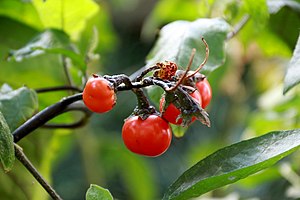Man-eater tomato
| Man-eater tomato | ||||||||||||
|---|---|---|---|---|---|---|---|---|---|---|---|---|

Man- eater tomato ( Solanum viride ) |
||||||||||||
| Systematics | ||||||||||||
|
||||||||||||
| Scientific name | ||||||||||||
| Solanum viride | ||||||||||||
| Blast |
The man -eater tomato ( Solanum viride ), also known as cannibal tomato, Poro Poro or Boro-dina , is a species of the nightshade family (Solanaceae). This makes it close relatives to tomatoes , potatoes and aubergines . This plant species got its unusual name because it is said to have been used by cannibalic tribes on the Fiji Islands to make human flesh more digestible .
description
The ogre-eater tomatoes are herbaceous plants of several years , they grow bushy and reach heights of up to 150 centimeters. The leaves are ovate and pointed. The flowers resemble those of other nightshades; they are white, five-lobed and have yellow stamens . After pollination , the flowers turn into red berries two to three centimeters in size that look like tomatoes.
The fruits are edible, but have a bitter taste when raw, which can be reduced by cooking. The leaves can be prepared as a salad. In the roots are poisonous steroid - alkaloids enriched.
origin
The home of the ogre tomato are Tahiti , Fijis, and other islands in the Pacific Rim. Outside of these areas, this plant species is occasionally cultivated as a container plant.
Botanical history

The first collections of the kind were created during James Cook's second research trip to New Zealand and the South Pacific (1772–1775) by Johann Reinhold Forster and his son Georg Forster . Since the name published in Georg Forster's dissertation De plantis esculentis insularum Oceaniae in 1786 is not validly published, the correct first description comes from the German botanist and physician Kurt Sprengel in 1807 under the name Solanum viride given by the Forsters on the herbarium specimens .
The plant was later described several times under other names, for example in 1852 by the French botanist Michel Félix Dunal under the name Solanum uporo , under which the plant can still often be found today. However, it was given the name man-eater tomato in 1864 by Berthold Seemann , which is also reflected in the scientific name Solanum anthropophagorum, which he gave. He reports that he learned from the Fijian inhabitants, who allegedly still lived " cannibalically " at that time , that human meat is difficult to digest, but that it becomes more digestible when it is prepared with three different types of plants. These species are on the one hand the man- eater tomato , on the other hand the leaves of Malawari ( Streblus anthropophagorum ) and Tudano ( Homalanthus nutans ). While Malawari and Tudano are wild-growing trees, the man-eater tomato was cultivated, often near the huts known as bure-ni-sa (house of the stranger) to which those killed in war were brought. According to Seemann, there was a superstition among the local population that touching children with hands that had previously touched human flesh causes disease. That's why the meat was only touched with long wooden forks.
Since Sprengel did not refer to any type specimen in his first description , but referred to the Forsters' documents in his herbarium for the descriptions, a specimen from this herbarium was identified as the lectotype in 1986 . In addition to the scientific species names Solanum uporo and Solanum anthropophagorum , Solanum patameense , Solanum polynesicum and Solanum savaiense are also scientific synonyms .
literature
- Berthold Seemann: Viti. An Account of a Government Mission to the Vitian Or Fijian Islands in the Years 1860-61. Macmillan & Co., Cambridge 1862.
- PJ Garnock-Jones: South Pacific Plants Named by KPJ Sprengel in 1807. In: Taxon. Volume 35, Number 1, February 1986. pp. 123-128.
Web links
- Man-eater tomato (Solanum uporo). At: Giftpflanze.com.
- Solanum viride. At: Cook Islands Biodiversity.
- Cannibal Tomato - Solanum uporo Dun. - Solanaceae. ( Memento from May 23, 2009 in the Internet Archive ). At: Ethno-botanik.org.
- Solanum viride Spreng. ( Memento of August 9, 2012 in the Internet Archive ). At: nhm.ac.uk.